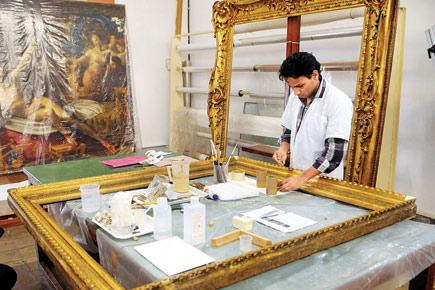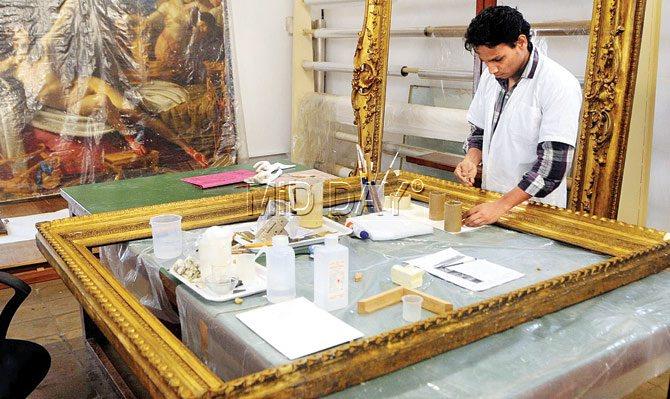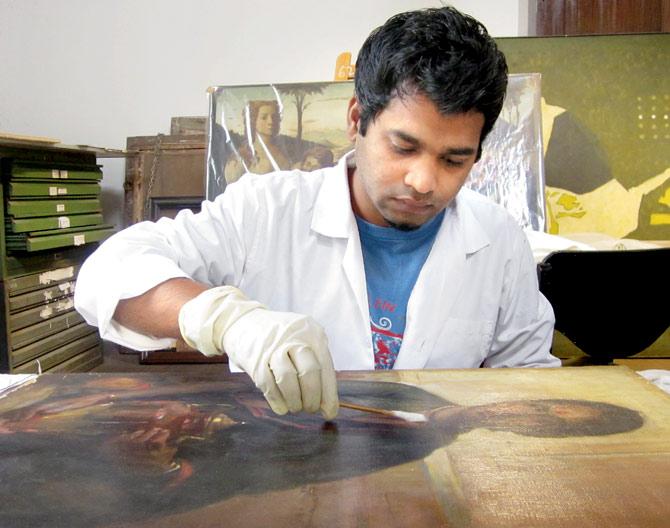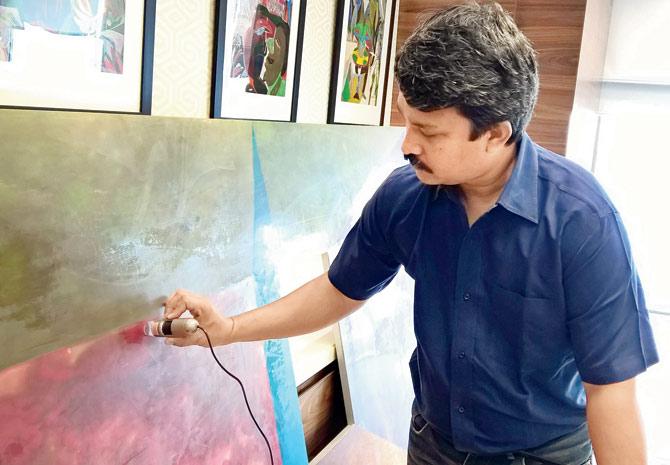City conservationists offer handy tips to combat moisture

Art restoration in progress at the Chhatrapati Shivaji Maharaj Vastu Sangrahalaya.
![]() Monsoon showers have brought much-needed relief from the heat, but with it also mold, mildew and insects. And if you have recently invested in artwork, concerns are born likely to be for its welfare. With this in mind, we got a few city art conservationists advise on the need to safeguard your art.
Monsoon showers have brought much-needed relief from the heat, but with it also mold, mildew and insects. And if you have recently invested in artwork, concerns are born likely to be for its welfare. With this in mind, we got a few city art conservationists advise on the need to safeguard your art.

Art restoration in progress at the Chhatrapati Shivaji Maharaj Vastu Sangrahalaya. Pic/Bipin Kokate
ADVERTISEMENT
Light matters
Sudhir Kumar Pradhan, art conservationist, who recently led a team of experts to preserve over 650 artworks at the Sir JJ School of Art, says fungus growth is one of the major problems faced during monsoon. Proper lighting can help keep it away.
However, light shouldn’t fall directly on an artwork, he warns. "Ideally, the source light should be directed towards the roof," he says, adding that using a light source with a UV filter should be preferred. Besides, a well-lit area also discourages growth of insects and keeps rodents away.

Sudhir Kumar Pradhan restores a painting.
Storage matters
Where you keep your artwork is as important as how. Ideally, paintings should be kept vertically at all times. "Generally one should avoid corners, near doors and windows, as they attract moisture from nearby areas. Also, you must maintain some gap between the wall and the painting to prevent any leakage in walls as moisture damages the artwork," says Pradhan.
But that’s not all. Anant Shelke who runs AMS Fine Art Conservation, a professional conservation and restoration studio based in Thane, warns against storing artwork in basements, attics or in dark areas as mold and mildew grow in a stagnant environment. "Try not to keep them wrapped up for too long in stacks, to avoid moisture buildup," says Shelke, adding that the place of storage should be well ventilated. "During periods of high humidity, use fans to circulate air and help discourage fungal growth," adds Shelke, who runs the art conservation firm with Madhura Shelke. Pradhan advises against packaging artwork during the monsoon, however, if it becomes a necessity one should use hydrophobic material like plastic. "Ideally, packaging of artworks should be done in a dry season, and before monsoon as the moisture in the air remain inside and damage the work. But if you must package and store your work, use more hydrophobic material like good quality plastic," he suggests.

Anant Shelke uses modern tools to analyse damage to a painting
Nature of material
The hygroscopic nature of the material of the artwork also matters, informs Pradhan. "Paper is more hygroscopic than canvas or vinyl. So, naturally, it attracts moisture faster. Hence special attention needs to be paid in storing artworks on paper. Besides, being organic in nature, they also attract insects that may leave stains and holes," he informs.
Isolate damaged work
Care should also be taken to not touch or wipe mold and mildew (if they appear) as their unique nature may leave stains and cause irreparable damage to the artwork. "If you see any fungal growth in your painting, or the presence of insects, isolate the painting immediately," says Shelke, adding, "Never use brush or cloth directly to remove the fungus as it may spread elsewhere. Contact a conservationist immediately to prevent it from further damaging the artwork."
The correct temperature
Temperature is another important factor that one should watch out for during monsoon, says Pradhan. "Ideally, you should store your artwork at a temperature between 18 to 25 degrees celsius," he adds.
Since ACs are unavoidable, gradually increasing and decreasing the temperature helps. "Temperature can be increased and maintained on 24-25 degrees for 30 minutes before shutting down," says Shelke.
 Subscribe today by clicking the link and stay updated with the latest news!" Click here!
Subscribe today by clicking the link and stay updated with the latest news!" Click here!







